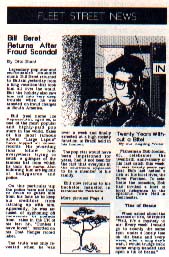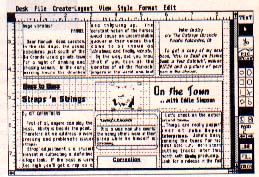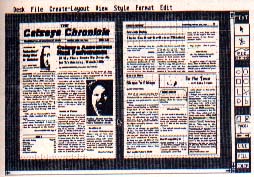DESKTOP PUBLISHING
Coming on strong: The ST as printing press
By Nat Friedland
Overnight, you could tell that desktop publishing had come to the ST. Suddenly it seemed as if every Atari users group newsletter was being designed and typeset with SoftLogik's Publishing Partner on standard dot-matrix printers--producing an instantly recognizable blocky-letter look.
But once they had tasted the artistic euphoria of desktop publishing, the speed at which these users group publishers upgraded the look of their newsletters was truly amazing. Often, within three or four issues, the newsletters went from 9-pin to 24-pin dot-matrix to some sort of laser printer--perhaps even a laser using the advanced Postscript page description language which allows extra-large headlines and a huge variety of typestyle treatments.
It's true that some major pieces are not yet in place on the chessboard of ST desktop publishing. The most significant example of this is Atari's own laser printer, coming soon for around $1,500. The latest word from Atari is that the interface boxes for these printers have just entered production. (The printers themselves are being provided by an independent Far East manufacturer.)
Currently ST users must resort to makeshift measures in order to achieve true state-of-the-art desktop publishing. Right now the choice is either to use impressive but not quite fully-polished programs written for the ST, or apply the brute power of the ST to emulate other computers that run today's state-of-the-art page design software.
However, a similar catch-up situation faced IBM users for two years until Ventura Publisher software brought it even with the Macintosh. So it's safe to say that the near-future potential of desktop publishing on the ST couldn't be brighter.
As we go to press, Publishing Partner ($149.95) is the only desktop publishing software written for the Atari ST that works on laser printers. It has a driver for the top-line Apple Laserwriter or any other other Postscript-capable printer. It will also run on the popular Hewlett-Packard laserjets. As new drivers are written--for either lasers or dot-matrix printers--SoftLogik releases them into public domain and makes them widely available online (Reviewed in START, Summer 1987.)
 |
| Fleet Street |
In general, SoftLogik has proven itself deeply committed to supporting Publishing Partner. This is an especially good thing because versions of the software released so far are not bug-free. A warning often heard from users of Publishing Partner is, "Save your documents often, so you won't lose much in a program crash." The other most commonly-heard complaint about Partner is its slowness when using the fourpass printing mode to squeeze maximum quality out of a standard 9-pin dot-matrix printer--perhaps as long as 20-30 minutes to print a single page containing graphics.
Still, even the quibblers usually agree that Publishing Partner is one of the most impressive programs yet released for the ST. The GEM-based user interface is comparatively easy, considering all the features that the program has to offer. You get the full WYSIWYG display (What You See Is What You Get) that is an accepted requisite of desktop publishing software.
Want to place text in a column? Start a box with the mouse and drag it to the desired size. Arrange columns and select "text routing" to make your words flow automatically from one column to the next. It's just as easy to import DEGAS or NEOchrome pictures, place them on your page in different sizes and flow your text around them. And you can set your page size to anything your printer will support.
Publishing Partner is a real desktop publishing program, made even more impressive by the fact that it's the work of one man, Deron Kazmaier, and is written entirely in 68000 assembly language. Considering the care that has already been lavished on this software, future low-cost upgrades of Publishing Partner can be expected to smooth out any rough spots remaining from earlier versions. Minimum requirement: 520ST with TOS in ROM. Monochrome monitor preferred. SoftLogic Corp., 4129 Old Baumgartner, St. Louis, MO 63129. (314) 894-8608.
From England's Mirrorsoft comes Fleet Street Publisher ($119), a polished program with many powerful features, some of them not available in other ST software. Distributed in the U.S. by Spectrum Holobyte, Fleet Street is completely GEM-based and elegantly performs virtually all the operations you would expect from a desktop publishing program.
Like Publishing Partner, Fleet Street contains a fairly bare-bones word processor, or lets you import ASCII text files from more powerful ST word processors. Both programs allow you to import and manipulate pictures from DEGAS or NEOchrome (MirrorSoft's new Art Director is also compatible with Fleet Street). You can do a bit of drawing with Fleet Street, but Publishing Partner gives you a full range of built-in shapes and fill patterns.
Fleet Street presently has two main advantages over Publishing Partner. For one thing, Fleet Street is currently a more reliable and bug-free program that's not as prone to crashes as Publishing Partner.
Fleet Street comes with six different typefaces (which could also be substituted with other GDOS fonts) while Publishing Partner is only being shipped with two typefaces right now. However, Fleet Street's six typefaces have fewer type styles than Publishing Partner--only normal, bold, italic and underline.
 |
| Publishing Partner: "Show Rulers" with "Show Full Width" |
Both programs essentially support the same type size range--Fleet Street goes from 4 to 72 points. But Fleet Street offers eight different units of measurement, while Publishing Partner only uses points. (A point is a printing measurement equal to 1/72 of an inch.)
On the other hand, some users may find that Fleet Street also has several significant limitations as compared to Publishing Partner. Perhaps the biggest stumbling block is that Fleet Street does not yet offer any laser printer drivers. However, Spectrum Holobyte has promised to create a $50 Postscript driver and a $30 driver for Atari's still unavailable laser printer.
Primarily designed for Epson FX-80 compatibles, Fleet Street does allow limited customizing of dot-matrix command sequences. It would be best to phone Spectrum Holobyte if you have any doubts about compatibility with your own printer. And our original review in the Fall 1987 START pointed out that Fleet Street's large-size dot-matrix type has a noticeably jagged and blocky appearance.
Fleet Street is heavily copy protected, unlike Publishing Partner. To run Fleet Street from your hard disk, you must always insert your original master disk into drive A when loading the program. Also there are no warning prompts to help prevent you from mistakenly deleting or overwriting files.
However, Fleet Street boasts fine documentation with a really excellent tutorial about creating a newsletter. The software also lets your documents use as much memory as your ST has available. And you can also conveniently create as many as 20 text or style macros for assignment to the ST's function keys.
 |
| Publishing Partner: The "Show Multiple Pages" option |
Fleet Street comes with a whole disk full of pictures arranged into categories. It is priced $30 dollars lower than Publishing Partner (although you will need to pay extra if you want laser printer drivers.) Depending on your immediate and future needs, either Fleet Street or Publishing Partner could be your best choice for getting started in desktop publishing on your ST. Minimum requirement: 520ST with TOS in ROM. Monochrome monitor preferred. Spectrum HoloByte, Inc., 2061 Challenger Drive, Alameda, CA 94501. (415) 522-3584
DESKTOP PUBLISHING SOFTWARE, NON-ATARI PROGRAMS AND THE ST
Never has an affordable computer like the Atari ST been powerful enough to give the user such a range of software translation choices. Although not all the ST's bridges to the Macintosh and the IBM PC are fully in place yet, even now there is no reason why you cannot run the best desktop publishing programs of these other computers on your ST.
Among the programs that work successfully on the ST with version 4.5 of the Magic Sac Macintosh emulator cartridge are Ready Set Go by Manhattan Graphics and Pagemaker 2.0 from Aldus. These two programs have set the standard for Mac desktop publishing. An ST conversion of Ready Set Go has been announced, but there is no firm release date yet.
At this writing, you still need to transfer programs into your ST from a genuine Macintosh and then convert them to ST disk format. But Magic Sac inventor David Small says that his customized disk drive interface which translates Macintosh programs directly to the ST is just about to be shipped. This means that effectively the Atari ST will be able to do everything that the Mac can--but faster, on a bigger screen, and for just about one-third the list price of a Macintosh.
As for IBM emulation on the ST, affordable PC Ditto software seems to work just fine. START has used it to run a number of MS-DOS programs including Flight Simulator II and Word Perfect on our STs. The only catch is that PC Ditto slows down the ST to make it even more pokey than a standard IBM XT.
However, Ventura Xerox Publisher has been widely reviewed as the best IBM desktop publishing software on the market. Admittedly, START has not yet tested the 11-disk Ventura package on our STs because we don't yet have a direct-connect 5 1/4 inch ST disk drive. But since Ventura is not copy-protected, there is no reason why it shouldn't run perfectly well on the ST with PC Ditto.
LASER CHOICES
With its built-in parallel and serial ports, your ST should be able to run just about any laser printer on the market today. Laser printing is one of the fastest-growing computer peripheral categories. New models are coming into the stores all the time and prices are steadily dropping.
The current resolution standard for laser printers is 300 dots per inch. Although traditional photo typesetting has a considerably higher resolution, the difference between laser and photo type is almost impossible to see with an untrained eye.
The main factor you must keep in mind when choosing a laser printer is its compatibility with the software you plan to use--plus of course the ever-present about how much you are willing to pay.
Your laser choices range all the way from printers running Postscript to printers that emulate popular standard formats--daisywheel letter-quality such as Diablo or Qume, or even Epson dot-matrix. If you do not need graphics capability, the letter-quality emulation lasers can produce impressive near-typeset quality text pages from just about any ST word processing software.
For example, a number of the best-looking Atari users newsletters used plain ST Writer for laser printing, because of this word processor's easy two-column page layout.
The forthcoming ST version of Word Perfect, which was shown at Atari Fairs throughout 1987, features flexible WYSIWYG multi-column printing and a complete roster of laser printer drivers. It also supports mixed type fonts on the same page and effortless box or line drawing. Just draw a box where you want to paste in your illustration and the text automatically flows around it.
As in the Mac and IBM worlds, top-line ST word processors can deliver many of the essential functions of desktop publishing software--and it may be all you need for your own uses. By the way, prototypes of the Atari laser printer shown at 1987 Atari Fairs were running the still-unreleased Microsoft ST Write word processor which produced many features offered by Word Perfect.
One final suggestion. You may be able to rent a laser printer and pay only a few cents per page, rather than buying your own laser printer right away. A number of high-tech photocopy centers have branched out into laser printing. This sort of service is often available in the vicinity of college campuses.
The only catch to this is that laser rental centers will probably just have Macintosh computers and maybe an IBM clone on-site. You'll have to decide whether it's worth it to you to lug down your own ST and monitor.
COMING SOON TO A DESKTOP NEAR YOU. . .
Timeworks Desktop Publisher (Price not set) Coming soon from Timeworks, Inc., makers of Swiftcalc, WordWriter ST and Data Manager ST--their own desktop publishing package--a typesetter, designer and paste-up artist all in one. Features a complete word processor, a variety of font styles, built in text editor, high resolution graphics and more! Timework's, Inc., 444 Lake Cook Road, Deer,peld, IL 60015. (312) 948-9200.